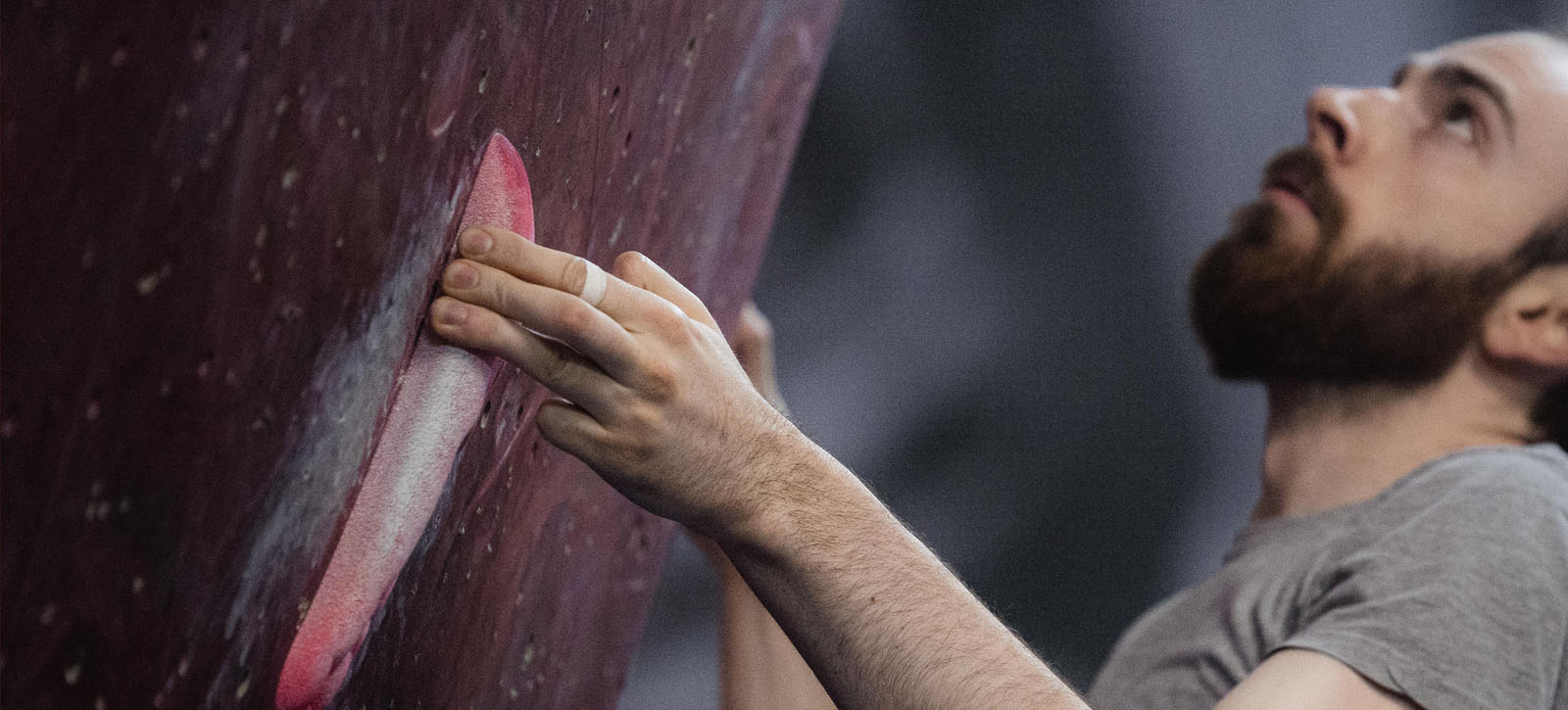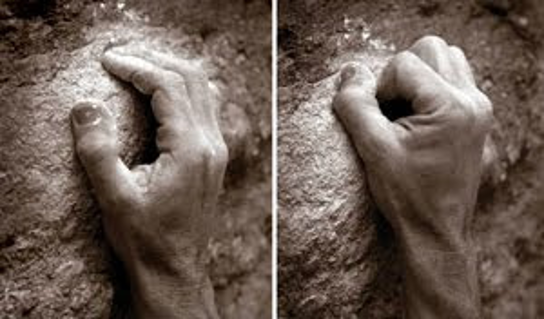27.02.20
Coping with climbing finger injuries
Rupert Cross takes a look at common climbing finger injuries. Coping with injury is psychologically and physically one of the biggest challenges for those who participate in sport. TCA Bristol-based Sports Osteopath, Rupert explores pulley injuries, helping you to identify the symptoms and plan a path for recovery.
Climbing finger injuries
We all know of someone or have experienced ourselves, the dreaded pulley injury. That sinking feeling when you are pulling on a hold and you hear or feel something strange in the finger. It can also just be a dull ache felt at the end of a session that has been hanging around for a while. Sudden onset of a finger injury is a strange sensation, you may hear a pop or a tear, but there is often no pain initially, but after a few minutes it may start to throb and swell. It is likely to be a flexor pulley injury and should be taken seriously. Stop climbing straight away and make efforts to not stress the finger for the rest of the day. The most common finger to sustain this injury is the ring finger. This is thought to be because the ring finger has only the support of the little finger, which is short and weaker compared to the others. When crimping, the hand naturally rotates towards the ring finger side placing further strain through the ring and little finger.
FINGER ANATOMY
The structure climbers tend to injure is the flexor tendon sheath. A structure that covers and lubricates the tendon as well as the pulley system. The pulley system is made up of thickened layers of the flexor tendon sheath, which holds the tendons to the bone known as annular and cruciate pulleys. There are five annular pulleys and three cruciate pulleys. It is more likely that you will injure the A2 as this pulley is under the most stress when using a closed crimp, up to four times more than when using an open crimp. The cruciate ligaments can be injured, but it is rare.
THE THREE COMMON REASONS FOR PULLEY INJURY
1) A foot suddenly slips increasing the load through the pulleys.
2) Repeatedly trying the same move, especially when using the campus board or a crimpy boulder problem.
3) Dynamic moves to small edges or pockets, the finger doesn’t have time to set itself to take the load.
HOW TO IDENTIFY A PULLEY INJURY
A full or partial rupture of a pulley is difficult to miss as there will be a tearing sound or an audible pop, sometimes so loud those around will hear it. There will be swelling soon after the injury with pain at the base of the finger, however, sometimes this can happen without experiencing any pain at all (obviously stop climbing immediately). Reduced mobility often occurs, meaning difficulty when closing the hand. It is important to get a diagnosis ASAP. This will drastically reduce your time away from climbing. An ultrasound may be needed to determine the extent of the injury. It is not uncommon to injure more than one pulley, eg A2, A3 and A4 can be injured at the same time. If only one pulley is ruptured, then conservative treatment can be used, however, if more than one pulley is ruptured then surgery will probably be required. If multiple ruptures occur, you can see a bowstringing which means as you use the tendon, it pulls away from the finger.
To assess if you think it may be a pulley injury, just pull very gently on an edge with an open hand, then the same in an open crimp. If there was no pain with the open hand, but you found pain with the crimp, this is a strong indicator for a pulley injury. In the early stages to test the extent of the injury, you can just push the injured finger against the thumb to see if you evoke pain and to what level. If this is done on a daily or weekly basis, it gives a rough guide on how the finger is recovering.
RECOVERY PERIOD AND GETTING BACK TO FULL POWER
As you can see from the table below all injuries do recover, even if surgery is required. When you are able to get back to climbing just depends on the extent of the injury. In the long term, climbers will be able to get back to their full strength, but this will only happen once the pulley has fully recovered. Mechanically you are not able to pull as hard through a partially recovered pulley.
REHAB – THE ROAD BACK TO CLIMBING
The time until a climber is back to full power is often different for different people, depending on their injury and commitment to the rehab. The good news is that during the rehab period, climbers can start climbing sooner than they think. In fact, climbing does make up a fair bit of the rehab process, as loading the injured area speeds the recovery. The difference between a strain, partial rupture and full rupture in climbing terms is just the time you will have to wait until you can start gentle climbing. When you are back to climbing it is a difficult balancing act between wanting to climb that harder problem with your friends and remembering to be conservative and avoid overloading the finger. Slowly progress through the weeks, increasing the load, with a mind on the pain level in the finger when doing so. There should be minimal pain when climbing, if there is more than this, then you are pulling too hard and you will need to back off.
Other areas you can help are taping, this offers minimal support, however, it does offer enough to make it worthwhile. It’s important when taping to not think that this is a protective mechanism for the finger, rather a reminder you need to take it easy. It does also reduce the fingers ability to fully crimp. The table listed above gives you a guide to how long you may need to continue taping the finger, depending on the severity of the injury.
It is very important to get a correct diagnosis as quickly as you can if you do suspect a more serious finger injury. If you have questions or are concerned about a finger injury, you are welcome to get in touch with me using the details below.
Book an appointment
 RUPERT CROSS
RUPERT CROSS
Sports Osteopath at the Mothership
rc.osteopathy@gmail.com
07828 74912
TREATMENT AND WELLBEING AT TCA
BRISTOL In addition to Rupert, TCA Bristol also plays host to Sports Massage Therapist Sarah Latham. Click on her name to find out more details including discounts for members.
GLASGOW In Glasgow, Jay from Ridgestone Physical Therapy runs a Drop-in Clinic in The Newsroom Cafe, every Wednesday from 5-9pm. Come and have a chat about any injuries or training support you may need.
Credits
Main image: Chris Houston.
Image 1: Training for climbers for Eric J Horst.
Image 2: Neuman DA. Kinesiology of the skeletal system. St Louis: Mosby 2002.
Image 3: Source unknown – please advise and we will add credit.
References and useful reading
1) Hochholzer T, Schoeffl V, Zapf J. One Move Too Many. How to Understand the Injuries and Overuse Syndroms of Rock Climbing. Lochner; 2003.
2) Schöffl V, Popp D, Küpper T, Schöffl I. Injury Trends in Rock Climbers: Evaluation of a Case Series of 911 Injuries Between 2009 and 2012. Wilderness Environ Med. 2015.
3) Schoffl, Hochholzer T. Winklemann HP, Strecker W. Pulley injuries in rock climbers. Wilderness Evironmed 2003.
4) Dave Macleod. Make or break. Rare breed productions 2015.







